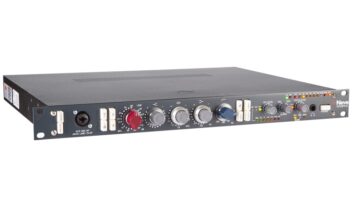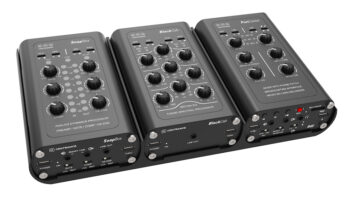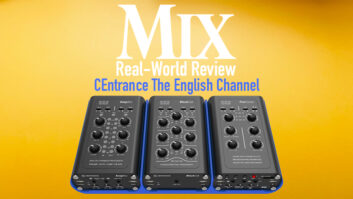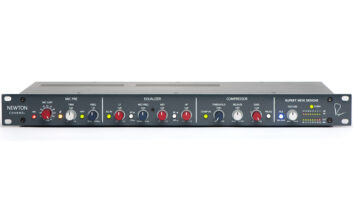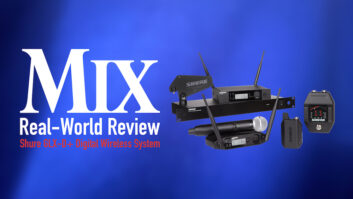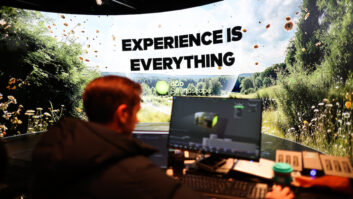Let’s face it, anyone who owns a recording studio-big or small-will eventually need some test equipment. But quality audio test gear costs thousands of dollars and requires a fair amount of real estate. If you need a real-time spectrum analyzer, an oscilloscope and a multi-stimuli signal generator, but are tight on cash and short on space, Channel D Corporation’s Mac the Scope software may be just the ticket.
Mac the Scope runs on Power Macs and FPU-equipped 680×0 Macs and requires System 7.5.3 or later and at least 8 MB of free RAM. A 180MHz or higher Mac is recommended due to the amount of processing power needed for simultaneously generating audio test stimuli and displaying incoming signals in real time. I tested the program on a 180MHz Power Computing clone, and there were moments when my processor bogged down: I can’t imagine using anything slower.
Audio signals can come from either the Mac’s mini-jack input or an audio CD played from the computer’s CD-ROM drive. If you’re using the mini-jack input, you’ll need a mini-jack-to-11/44-inch (or RCA) Y-cable. An identical adapter is required for the mini-jack output when using the program to generate test stimuli. With these adapters, the Mac’s stereo ins and outs are split into two channels (Channel 1 and Channel 2), creating the necessary sends and returns for bench testing.
Mac the Scope can capture real-time bandwidth, sampling up to 44.1 kHz. However, sample rates depend entirely on CPU speed, and slower computers may be locked into lower rates-22.05 or 11.025 kHz.
UP AND RUNNINGGetting Mac the Scope up and running was a breeze. Initially, I ran into sluggish, or delayed, traces and meters. However, the manual indicated this was due to my monitor being set to millions of colors and running a menu bar clock. To allocate sufficient processing power to run the program, desktop accessories and other ongoing background applications should be turned off. The program will operate in millions (or thousands) of colors, but screen redraw (in particular, the real-time traces) is smoothest at a 256-color setting. Also, Channel D warns that using virtual memory may interfere with the program’s performance.
Mac the Scope’s main window has a large, real-time trace area surrounded by a plethora of control elements and displays. The control elements range from buttons to faders, and the displays range from signal-present LEDs to text bars. Control elements are roughly divided into 11 sections: amplitude axis scaling, x-axis scaling, operation modes, display modes, signal averaging, test signal generator, incoming signal control, input level triggering, Channel 1 vs. Channel 2 comparisons (trace math), calibration and saving.
The number of controls presented in the main window can be a bit daunting, especially if you’re not familiar with the type of equipment it’s modeled after. Even though I am familiar with such equipment, I sometimes found it difficult to locate the function I was looking for. Operation would be smoother if the control elements and displays were user-configurable. In most modes, there are several unused elements that simply clutter the screen. The ability to re-size and rearrange elements so only active controls and displays are in view would make the user interface more intuitive.
One button takes you to the program’s RTA, a useful mode for performing transfer function measurements. The trace display is split into two horizontal areas: The top display shows the frequency magnitude of Channel 1 while the bottom shows the amplitude transfer function (Channel 2 divided by Channel 1). The RTA’s use of text files is wonderful, allowing the creation of user-definable filter frequencies: Just make a text file that contains the numerical values of your desired filter frequencies and calibration curves and open it with the RTA. The program also includes octave, half-octave and third-octave center-frequency filter text files.
Mono or stereo spectrograms can be created in various colors, including False-Color, Grayscale, Inverted, Embossed, Metallic and 3-D. With False-Color and Gray-scale representations, the lighter shades show the higher-amplitude signals and the darker shades show the lower-amplitude signals. The relationship between light and dark shades can be reversed or Inverted. Embossed and Metallic settings produce grayscale images with a 3-D lighting effect. The 3-D setting yields a sort of topographical image, in color. The spectrogram shows gaps during sampling due to CPU timeouts (more common with slower Macs). The ability to see if the sampling data stream is unbroken is key in determining precision of the spectrogram image when viewing time records. Spectrogram records can be viewed horizontally or vertically.
In its oscilloscope mode, the trace area’s background changes to an oscilloscope green-just like the real thing. The screen can be split horizontally, with the top showing Channel 1 and the bottom displaying Channel 1 vs. Channel 2. The Trace Math control section allows the user to view amplitude and phase differences between the two channels. You can also switch from the linear image to a Lissajous image to view the same information in a nonlinear context.
A handy stimuli generator algorithm makes Mac the Scope completely self-contained-no need to dig up its analog equivalent buried on your workbench. Stimuli include Random (similar to white noise); Pink Filtering, a full-bandwidth noise but with high frequencies attenuated by 3 dB/octave; Chirp, a pulsed sine wave that increases in frequency over time; Sinusoidal, a steady tone with adjustable frequency and sweep; and Arbitrary, a user-definable stimulus that can be driven via a text file just like the RTA’s frequency filters. The stimuli worked pretty well most of the time, though I experienced intermittent hiccups with the Sinusoidal and noise generator algorithms (the steady sound stimuli). Channel D informed me that this was a known problem and that it would be fixed in an upcoming version due out by NAMM.
I enjoyed Mac the Scope’s many options for displaying incoming source information (an advantage the software has over dedicated hardware systems). Signals can be viewed on simple green-yellow-red LED elements or full-length LED meters. There’s also an optional VU meter window complete with peak LED indicators that’s quite nice. Placing the cursor over the trace window automatically displays the Hz and dBV (or other appropriate measurements) in text attached to the cursor’s tail. A separate oversized window is also available to display this information. A legend window can present everything from the cursor value to the date, and this same information can be made to appear in the top right corner of the trace area. And, both spectrogram and oscilloscope traces can be displayed in either continuous waveform lines or dots.
Snapshots of Mac the Scope’s traces can be saved as PICTs, which is useful for comparing and referencing images at a later date. A Pause button will freeze the trace for a minute without saving it. The program is designed to save its current state upon quitting, but I found the information it saved to be incomplete. While some button states and options were saved, many were not. It can be difficult to remember all the settings you had the last time you used the program, and I hope that the Save-State function is more comprehensive in future versions.
THE SCOOP ON THE SCOPEI was concerned that the computer’s method of processing information would be problematic in capturing meaningful traces, and that sampling would be irretrievably fragmented as the processor timed in and out to perform multiple tasks. Channel D has developed a method it calls Coherent Sampling to get around this. Mac the Scope uses multiple waveform buffers to allow simultaneous waveform capture, processing and the real-time graphics display. An input buffer is filled with incoming samples while an already filled buffer is processed, which allows Sound Manager to interrupt other systems on the computer in order to manage the buffers, all without losing the input stream. A Coherent Sampling Indicator located above the trace window glows green when there are no sample gaps and blinks gray when gaps occur. Again, how fluid and transparent this process is depends on your processor speed and the amount of free system RAM.
I was also concerned about the S/N ratio of Mac mic inputs. However, Mac the Scope can perform signal averaging while capturing waveforms. Occurring in the software’s power spectrum calculation, this improves the noise floor of incoming signals beyond the actual sampling resolution. Noise floor is also improved in higher Time Base Expansion modes, which applies a multitap, IIR, lowpass digital filter to the digitized input signal before resampling to the displayed waveform input points (1,024 or 2,048 sample points in the trace area).
The Time Base Expansion function lets you change the visible frequency, or time span, by factors of two. This allows adjusting the frequency range to increase low-frequency resolution. At 44.1 kHz and a Time Base Expansion of X2, the frequency span goes to 11 kHz. Changing the Time Base Expansion to X1 lets you increase the frequency span to 22 kHz at 44.1 kHz.
Along with signal averaging, Mac the Scope uses overlapping to fully capture incoming signals. Select the Overlap button, and each incoming frame is combined with 50% of the previous frame, processed, averaged and then processed and averaged again using the most recent trace record. This increases averaging throughput and decreases the effect of signal attenuation with a power spectrum weighting function.
Weighting is accessed via the program’s windowing function. Windowing allows you to preprocess each incoming frame so that during power spectrum analysis, amplitude spikes at the edges of frames can be eliminated. Windowing functions include Welch, Bartlett, Hann, Hamming, Cosine4 and Square Top (no windowing). The windowing shapes can be graphically displayed by using Balloon Help and selecting the windowing function you want to see.
Overall, Mac the Scope seemed to work well. I ran into a few technical problems (the stimuli) and implementation problems (a cluttered main window), but these didn’t overly interfere with the program’s basic operation. All told, it’s hard to go wrong with software that turns your computer into a solid audio test machine for only $399. What else lets you generate test stimuli, check the phase on stereo signals, analyze a mix’s frequency content, tweak a device’s frequency response and signal throughput, or view sound wave reflections while you tune a room for under four C-notes? Version updates are readily available via Channel D’s Web site, as are application tips and updates to the manual.
Channel D Corporation, Nine Highland Ave., Red Bank, NJ 07701; 732/ 933-9388; fax 732/933-9389. Web site: www.channld.com/software.html.
